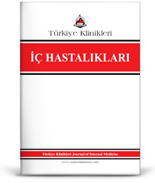İnvaziv aspergilloz, özellikle immün sistemi baskılanmış hastalarda, yüksek morbidite ve mortalite ile seyreden önemli bir fungal enfeksiyondur. En sık akciğeri etkilemekle birlikte mantar, vücudun diğer organlarına da yayılarak hastalık yapabilir. Aspergillus fumigatus, invaziv aspergillozlu olgularda en sık etkendir. Aspergillus flavus ise bronkopulmoner enfeksiyonların yaklaşık olarak %10'undan sorumludur. İnvaziv aspergillozun tedavisinde vorikonazol 1. seçenek antifungaldır. Vorikonazol alamayacak ya da vorikonazole cevap vermeyen hastalarda tedavide alternatif olarak; isavukonazol, amfoterisin B lipid formülasyonu, itrakonazol, kaspofungin, mikafungin ve posakonazol kullanılabilir. Burada akut lenfoblastik lösemi tanılı bir hastada, A. flavus'un etken olduğu ve vorikonazol ile tedavi edilen bir invaziv pulmoner aspergilloz olgusu sunulmaktadır.
Anahtar Kelimeler: Aspergillus flavus; invaziv pulmoner aspergilloz; immünsupresyon
Invasive aspergillosis is an important fungal infection with high morbidity and mortality, especially in immunocompromised patients. Although invasive aspergillosis most commonly affects the lungs, Aspergillus can also spread throughout the body and cause infection in other organs. Aspergillus fumigatus is the most common cause of invasive aspergillosis. Aspergillus flavus is responsible for approximately 10% of bronchopulmonary infections. Voriconazole is the firstline antifungal agent in the treatment of invasive aspergillosis. Other antifungal agents including isavuconazole, lipid amphotericin formulations, itraconazole, caspofungin, micafungin, and posaconazole can be used to treat invasive aspergillosis in patients who can not take voriconazole or who have not responded to voriconazole. We present a case of invasive pulmonary aspergillosis caused by A. flavus and treated with voriconazole in a patient with acute lymphoblastic leukemia.
Keywords: Aspergillus flavus; invasive pulmonary aspergillosis; immunosuppression
- Soubani AO, Chandrasekar PH. The clinical spectrum of pulmonary aspergillosis. Chest. 2002;121(6):1988-99. [Crossref] [PubMed]
- Krishnan S, Manavathu EK, Chandrasekar PH. Aspergillus flavus: an emerging non-fumigatus Aspergillus species of significance. Mycoses. 2009;52(3):206-22. [Crossref] [PubMed]
- Rudramurthy SM, Paul RA, Chakrabarti A, Mouton JW, Meis JF. Invasive aspergillosis by Aspergillus flavus: Epidemiology, diagnosis, antifungal resistance, and management. J Fungi (Basel). 2019;5(3):55. [Crossref] [PubMed] [PMC]
- Gerson SL, Talbot GH, Hurwitz S, Strom BL, Lusk EJ, Cassileth PA. Prolonged granulocytopenia: the major risk factor for invasive pulmonary aspergillosis in patients with acute leukemia. Ann Intern Med. 1984;100(3):345-51. [Crossref] [PubMed]
- Walsh TJ, Anaissie EJ, Denning DW, Herbrecht R, Kontoyiannis DP, Marr KA, et al; Infectious Diseases Society of America. Treatment of aspergillosis: clinical practice guidelines of the Infectious Diseases Society of America. Clin Infect Dis. 2008;46(3):327-60. [Crossref] [PubMed]
- Rankin NE. Disseminated aspergillosis and moniliasis associated with agranulocytosis and antibiotic therapy. Br Med J. 1953;1(4816):918-9. [Crossref] [PubMed] [PMC]
- Wald A, Leisenring W, van Burik JA, Bowden RA. Epidemiology of Aspergillus infections in a large cohort of patients undergoing bone marrow transplantation. J Infect Dis. 1997;175(6): 1459-66. [Crossref] [PubMed]
- Kousha M, Tadi R, Soubani AO. Pulmonary aspergillosis: a clinical review. Eur Respir Rev. 2011;20(121):156-74. [Crossref] [PubMed]
- Ruhnke M, Böhme A, Buchheidt D, Donhuijsen K, Einsele H, Enzensberger R, et al; Infectious Diseases Working Party (AGIHO) of the German Society of Hematology and Oncology (DGHO). Diagnosis of invasive fungal infections in hematology and oncology--guidelines of the Infectious Diseases Working Party (AGIHO) of the German Society of Hematology and Oncology (DGHO). Ann Hematol. 2003;82 Suppl 2:S141-8. [Crossref] [PubMed]
- Hope WW, Walsh TJ, Denning DW. Laboratory diagnosis of invasive aspergillosis. Lancet Infect Dis. 2005;5(10):609-22. [Crossref] [PubMed]
- Oz Y, Kiraz N. Diagnostic methods for fungal infections in pediatric patients: microbiological, serological and molecular methods. Expert Rev Anti Infect Ther. 2011;9(3):289-98. [Crossref] [PubMed]
- Herbrecht R, Denning DW, Patterson TF, Bennett JE, Greene RE, Oestmann JW, et al; Invasive Fungal Infections Group of the European Organisation for Research and Treatment of Cancer and the Global Aspergillus Study Group. Voriconazole versus amphotericin B for primary therapy of invasive aspergillosis. N Engl J Med. 2002;347(6):408-15. [PubMed]
- Öz Y, Akşit F, Aslan M, Kaşifoğlu N, Kiraz N. Klinik Aspergillus izolatları: Tür dağılımı ve antifungal duyarlılık sonuçlarının değerlendiril mesi [Clinical Aspergillus isolates: evaluation of species distribution and antifungal susceptibility results]. Ankem Derg. 2012;26(2):69-73. [Crossref]
- Ullmann AJ, Aguado JM, Arikan-Akdagli S, Denning DW, Groll AH, Lagrou K, et al. Diagnosis and management of Aspergillus diseases: executive summary of the 2017 ESCMID-ECMM-ERS guideline. Clin Microbiol Infect. 2018;24 Suppl 1:e1-e38. [Crossref] [PubMed]
- Walsh TJ, Raad I, Patterson TF, Chandrasekar P, Donowitz GR, Graybill R, et al. Treatment of invasive aspergillosis with posaconazole in patients who are refractory to or intolerant of conventional therapy: an externally controlled trial. Clin Infect Dis. 2007;44(1):2-12. [Crossref] [PubMed]







.: Process List